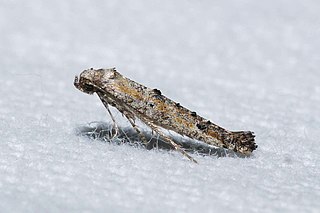Paraplatyptilia carolina is a moth of the family Pterophoridae described by William D. Kearfott in 1907. It is found in the southeastern United States, including Florida, southern Mississippi, North Carolina and Georgia.

Phalonidia lavana, or Platphalonidia lavana, is a species of moth of the family Tortricidae, the subfamily Tortricinae, and the tribe Cochylini. It has a terrestrial habitat and is found throughout North America. It does not have a Global Conservation Status Rank.
Fissicrambus intermedius is a moth in the family Crambidae. It was described by William D. Kearfott in 1908. It has been recorded from the US states of Arizona, California and Texas.

Agonopterix senicionella is a moth in the family Depressariidae. It was described by August Busck in 1902. It is found in North America, where it has been recorded from Kentucky, Michigan, Ohio, Virginia and West Virginia.

Eucosma abstemia is a species of moth of the family Tortricidae first described by Edward Meyrick in 1932. It is found in the United States, where it has been recorded from Colorado, Arizona and California.

Ochromolopis is a genus of moths in the family Epermeniidae described by Jacob Hübner in 1824.
Epermenia epispora is a moth in the family Epermeniidae. It was described by Edward Meyrick in 1897. It is found in Australia, where it has been recorded from Queensland and New South Wales.

Epermenia exilis is a moth in the family Epermeniidae. It was described by Edward Meyrick in 1897. It is found in Australia, where it has been recorded from South Australia and New South Wales.
Gnathifera eurybias is a moth in the family Epermeniidae. It was described by Edward Meyrick in 1897. It is found in Australia, where it has been recorded from New South Wales, Queensland, Victoria, Tasmania and South Australia.
Tanaoctena pygmaeodes is a moth in the family Galacticidae. It was described by Turner in 1926. It is found in Australia, where it has been recorded from Tasmania.
Tanaoctena ooptila is a moth in the family Galacticidae. It was described by Turner in 1913. It is found in Australia, where it has been recorded from Queensland.
Dichomeris capnites is a moth in the family Gelechiidae. It is found in Australia, where it has been recorded from Queensland and South Australia.
Hypatima euplecta is a species of moth in the family Gelechiidae. It was described by Edward Meyrick in 1904. It is found in Australia, where it has been recorded from Queensland, New South Wales, Victoria and South Australia.
Prolita invariabilis is a moth of the family Gelechiidae. It was described by William D. Kearfott in 1908. It is found in the US states of Utah, Wyoming, Arizona, California, Colorado, Oregon and New Mexico.
Gnorimoschema busckiella is a moth in the family Gelechiidae. It was described by William D. Kearfott in 1903. It has been recorded from the US states of Maine, New Jersey and Ohio.
Scrobipalpula artemisiella, the thyme moth, is a moth in the family Gelechiidae. It was described by William D. Kearfott in 1903. It is found in the United States, where it has been recorded from California, Arizona, Illinois, Maine, Maryland and Ohio.
Anacampsis paltodoriella is a moth of the family Gelechiidae. It was described by August Busck in 1903. It is found in North America, where it has been recorded from California, Arizona, New Mexico and Texas.
Theisoa pallidochrella is a moth of the family Gelechiidae. It was described by Vactor Tousey Chambers in 1873. It is found in North America, where it has been recorded from Kentucky and Illinois.
Taygete sylvicolella is a moth in the family Autostichidae. It was described by August Busck in 1903. It is found in North America, where it has been recorded from Illinois, Maine, New York, Ohio and South Carolina.
Moca aphrodora is a species of moth in the family Immidae first described by Edward Meyrick in 1922. It is found in Brazil and Peru.




